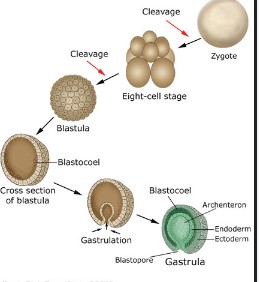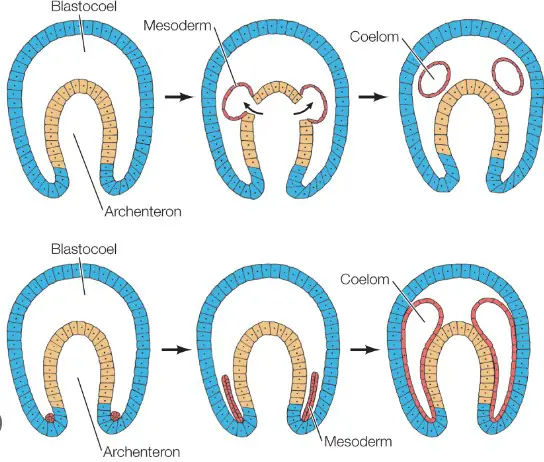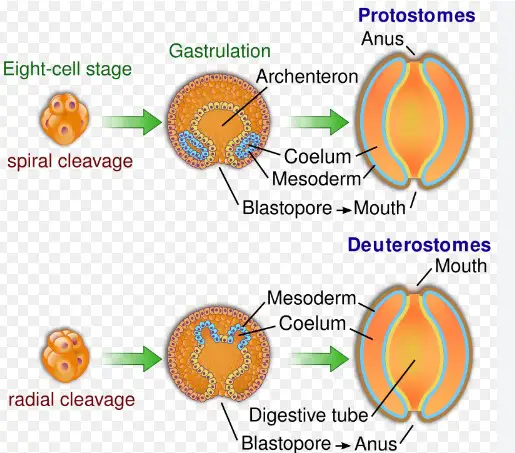Embryonic development is a complex process that marks the beginning of life for all multicellular organisms. This intricate journey from a single cell to a fully formed organism involves several key stages and structures, each playing a pivotal role. Among these, the archenteron and blastocoel are fundamental yet often misunderstood elements. Their distinct roles and interactions underpin much of early development, laying the groundwork for the body’s eventual form and function.
The archenteron and blastocoel are two critical structures in the early embryonic development of multicellular organisms. The archenteron, precursor to the gut, forms during gastrulation and eventually develops into the animal’s digestive tract. In contrast, the blastocoel is a fluid-filled cavity within the blastula, serving as a protective environment for the developing embryo. These structures not only differ in function but also in their formation and timing during development.
These early developmental structures provide a fascinating glimpse into the orchestrated complexity of life’s beginnings. The formation of the archenteron and blastocoel reflects a series of regulated cellular movements and changes, crucial for proper organismal development. Their study not only offers insights into the biological blueprint of multicellular life but also into the evolutionary mechanisms that have shaped it.

Early Development
Overview of Embryogenesis
Embryogenesis is the journey that transforms a single fertilized egg into a fully formed organism. This process is both fascinating and complex, involving a series of stages that occur in a precise order. At the heart of embryogenesis are cellular division, differentiation, and specialization, where initially identical cells become distinct types to form various tissues and organs.
Key steps in embryogenesis include:
- Fertilization: The union of sperm and egg to form a zygote.
- Cleavage: Rapid cell division without growth, leading to the formation of many smaller cells.
- Blastulation: The development of a blastula, a hollow ball of cells with a fluid-filled cavity called the blastocoel.
- Gastrulation: A pivotal stage where cells begin to move and organize into layers, forming the archenteron, the precursor to the gut.
- Organogenesis: The formation of organs from the embryonic layers established during gastrulation.
Embryogenesis is not just a biological marvel; it is a window into the fundamental principles that govern life itself.
Key Terms in Embryology
In the study of embryology, certain terms are essential for understanding the complex processes at play. Here are some key terms:
- Zygote: The initial cell formed when a sperm cell fertilizes an egg cell.
- Blastula: An early stage in embryonic development, characterized by a hollow sphere of cells surrounding a fluid-filled inner cavity.
- Gastrula: The stage following the blastula, where the embryo begins to form distinct layers.
- Blastocoel: The fluid-filled cavity within the blastula.
- Archenteron: The rudimentary alimentary canal formed during gastrulation.
These terms are foundational for anyone delving into the field of developmental biology.
Archenteron
Definition
The archenteron is a critical embryonic structure, marking the beginning of the digestive tract. It forms during gastrulation, a key phase in embryogenesis where the simple blastula reorganizes into a more complex structure. The archenteron eventually evolves into the gut, including the stomach, intestines, and associated structures.
Role in Development
The formation of the archenteron is a milestone in embryonic development, signifying the transition from a simple cell mass to a structured organism with a defined body plan. It is the site where the first germ layers—the ectoderm, mesoderm, and endoderm—start to differentiate, laying the groundwork for the development of all organs and tissues.
Formation Process
The process of archenteron formation involves several key steps:
- Invagination: The inward folding of a region of cells on the surface of the blastula.
- Elongation: The extension of the invaginated section to form a tube-like structure.
- Differentiation: The cells of the archenteron start to specialize, forming the lining of the future digestive tract.
Blastocoel
Definition
The blastocoel is a fluid-filled cavity within the blastula, an early stage in embryonic development. It serves as a critical space, providing the developing cells with a supportive environment. The blastocoel is essential for the structural integrity of the blastula, preventing the cells from collapsing under their own weight.
Function in Embryo
The blastocoel plays several important roles in embryonic development:
- Protection: It cushions the developing cells, protecting them from mechanical stress.
- Spatial organization: It helps organize cell layers, facilitating the processes of differentiation and specialization.
- Nutrient distribution: Although not directly involved in nutrient transport, its presence aids in the efficient distribution of nutrients among the cells.
Formation Mechanics
The formation of the blastocoel is a result of cell division and fluid accumulation. Here’s how it happens:
- Cell Division: Following fertilization, the zygote undergoes rapid division to form a multicellular structure.
- Fluid Accumulation: As cells divide, they secrete fluids into the interior space, creating the blastocoel.

Comparing Archenteron and Blastocoel
Structural Differences
The archenteron and blastocoel are two structures essential to embryonic development, each with unique physical characteristics. The archenteron, a tube-like cavity, forms during gastrulation and is the precursor to the gut. Its structure is defined by the invagination of cells, creating a hollow passage that will eventually develop into the digestive tract. In contrast, the blastocoel is a fluid-filled cavity within the blastula stage, providing a protective space for cell division and movement. This difference in structure reflects their diverse roles in development: one as a foundational organ system, the other as a supportive environment for early growth.
Functional Variances
The functions of the archenteron and blastocoel further highlight their differences. The archenteron’s primary role is in organ development, particularly the digestive system. It serves as a guide for the differentiation and organization of cells into functional tissues. The blastocoel, on the other hand, acts as a cushion and space facilitator, ensuring that embryonic cells can move and grow efficiently. It’s integral for maintaining the structural integrity of the embryo during early stages but doesn’t directly contribute to the formation of organs.
Developmental Timing
The timing of their formation and relevance during embryogenesis also differs. The blastocoel emerges first, during the blastula stage, setting the stage for subsequent embryonic development by creating the physical conditions necessary for cell division and specialization. The archenteron appears later, during gastrulation, marking a significant phase where the embryo begins to form distinct layers that will develop into various organ systems. This sequential appearance underscores their roles in the choreography of development, from creating an embryonic structure to defining the body plan.
Significance in Embryology
Impact on Organ Formation
The archenteron’s impact on organ formation is profound. As the embryonic structure that will become the digestive tract, its development influences the arrangement and differentiation of cells that will form essential organs. This process is not only critical for the digestive system but also influences the development of other systems, like the respiratory and urogenital systems, due to the shared embryonic origins of many organs.
Evolutionary Perspective
From an evolutionary standpoint, the presence and function of the archenteron and blastocoel offer insights into the development of multicellular life. The mechanisms that drive their formation reveal the adaptive strategies that have allowed complex organisms to evolve from simpler ancestors. The evolution of the archenteron, for example, highlights the increasing complexity of organisms, enabling more specialized and efficient digestive systems. The blastocoel’s role in providing a protective environment for early development reflects the fundamental need for stability during the most vulnerable stages of life.
Research and Studies
Recent Findings
Recent research has shed new light on the intricate processes governing the formation and function of the archenteron and blastocoel. Advances in genetic and molecular biology have revealed the specific genes involved in their development and how these genes are regulated. For example, studies have identified key signaling pathways that guide the formation of the archenteron, offering potential insights into congenital digestive tract disorders.
Future Directions
The ongoing exploration into the archenteron and blastocoel is paving the way for future directions in embryological research. One promising area is the use of stem cells to mimic embryonic development, providing a powerful tool for studying early human development and disease. Another exciting frontier is the potential for regenerative medicine. By understanding how these structures form and function, scientists hope to harness their principles to regenerate damaged organs or tissues.
Frequently Asked Questions
What is the archenteron?
The archenteron is an embryonic precursor to the gut that forms during the gastrulation phase of development. It is a tube-like structure that eventually evolves into the digestive tract of an organism. This crucial developmental step marks the differentiation of embryonic cells into distinct layers, leading to the formation of various organs and systems.
How does the blastocoel form?
The blastocoel forms during the blastula stage of embryonic development. It is created when cells divide and organize around a fluid-filled cavity. This cavity plays a key role in the embryo’s development, providing a cushioned environment that protects the cells and supports further cellular organization and differentiation.
Why are the archenteron and blastocoel important?
The archenteron and blastocoel are fundamental to the proper development of multicellular organisms. The archenteron initiates the formation of the digestive system, while the blastocoel supports the embryo as it grows and cells differentiate. Understanding these structures is essential for grasping how complex organisms develop from a single cell, highlighting their importance in both developmental biology and evolutionary studies.
Conclusion
The journey from a single cell to a complex organism is an awe-inspiring process, underpinned by structures like the archenteron and blastocoel. These elements are not just milestones in embryonic development but also keys to understanding the fundamental processes that drive the formation of life. By exploring these structures, scientists and enthusiasts alike gain insights into the intricate dance of cellular development, differentiation, and organization.
The study of the archenteron and blastocoel extends beyond academic interest, offering potential applications in medical science, evolutionary biology, and beyond. Their roles in the early stages of life underscore the complexity and elegance of biological development, inviting further exploration into the mysteries of life’s beginnings. As we continue to uncover the secrets of these embryonic structures, we deepen our appreciation for the marvels of nature and the intricate processes that make life possible.

